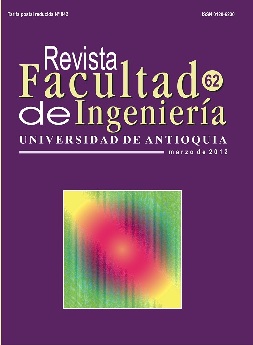Mechanical properties and absorption of chlorides in alkali activated slag concrete and exposed to carbonation
DOI:
https://doi.org/10.17533/udea.redin.12479Keywords:
alkali-activated slag concrete, Portland concrete, carbonation, compressive strength, permeable voids, absorption, chloride permeability, granulated blast-furnace slagAbstract
This paper presents an experimental study on the durability properties of carbonated alkali-activated slag (AAS) concrete. An ordinary Portland cement (OPC) was also tested for comparative purposes. The durability properties were studied through the measurements of compressive strength, permeable voids, and water absorption and chloride permeation. The results indicated that the AASs showed higher compressive strength at early ages than the OPCs. Contrary, permeable voids and water absorption measurements were lower for AASs than for OPCs.
Downloads
References
H. Song, V. Saraswanthy. “Studies on the corrosion resistance of reinforced steel in concrete with ground granulated blast-furnace slag.” J Hazard Mater. Vol. 138. 2006. pp. 226-233. DOI: https://doi.org/10.1016/j.jhazmat.2006.07.022
D. Bastidas, A. Fernández, A. Palomo, J. González. “A study on the passive state stability of steel embedded in activated fly ash mortars.” Corros Sci. Vol. 50. 2008. pp. 1058-1065. DOI: https://doi.org/10.1016/j.corsci.2007.11.016
E. Rodríguez, S. Bernal, R. Mejía de Gutiérrez, F. Puertas. “Alternative concrete based on alkaliactivated slag”. Mater Construcc. Vol. 58. 2008. pp. 53-67.
E. Rodríguez, S. Bernal, R. Mejía de Gutiérrez, F. Puertas. “Alternative concrete based on alkaliactivated slag”. Mater Construcc. Vol. 58. 2008. pp. 53-67. DOI: https://doi.org/10.3989/mc.2008.v58.i291.104
ASTM C 989-99 Standard. Standard specification for ground granulated blast-furnace slag for use in concrete and mortars. West Conshohocken, PA, American Society for Testing and Materials. 1999.
ASTM C 150-02 Standard. Standard specification for Portland cement. West Conshohocken, PA, American Society for Testing and Materials. 2002.
ASTM C 42/C 42M-04 Standard. Standard test method for obtaining and testing drilled cores and sawed beams of concrete. West Conshohocken, PA, American Society for Testing and Materials. 2004.
ASTM C 642-06 Standard. Standard test method for density, absorption, and voids in hardened concrete. West Conshohocken, PA, American Society for Testing and Materials. 2006.
ASTM C 1202-07 Standard. Standard test method for electrical indication of concrete’s ability to resist chloride ion penetration. West Conshohocken, PA, American Society for Testing and Materials. 2007.
F. Puertas, M. Palacios, T. Vázquez. “Carbonation process of alkali-activated slag mortars.” J Mater Sci. Vol. 41. 2006. pp. 3071-3082. DOI: https://doi.org/10.1007/s10853-005-1821-2
S. Wang, K. Scrivener. “Hydration products of alkali activated slag cement.” Cement Concrete Res. Vol. 25. 1995. pp. 561-571. DOI: https://doi.org/10.1016/0008-8846(95)00045-E
M. Palacios, F. Puertas “Effect of carbonation on alkali-activated slag paste.” J Am Ceram Soc. Vol. 89. 2006. pp. 3211-3221. DOI: https://doi.org/10.1111/j.1551-2916.2006.01214.x
C. Shi. “Strength, pore structure and permeability of alkali-activated slag mortars.” Cement Concrete Res. Vol. 26. 1996. pp. 1789-1799. DOI: https://doi.org/10.1016/S0008-8846(96)00174-3
Downloads
Published
How to Cite
Issue
Section
License
Copyright (c) 2018 Revista Facultad de Ingeniería

This work is licensed under a Creative Commons Attribution-NonCommercial-ShareAlike 4.0 International License.
Revista Facultad de Ingeniería, Universidad de Antioquia is licensed under the Creative Commons Attribution BY-NC-SA 4.0 license. https://creativecommons.org/licenses/by-nc-sa/4.0/deed.en
You are free to:
Share — copy and redistribute the material in any medium or format
Adapt — remix, transform, and build upon the material
Under the following terms:
Attribution — You must give appropriate credit, provide a link to the license, and indicate if changes were made. You may do so in any reasonable manner, but not in any way that suggests the licensor endorses you or your use.
NonCommercial — You may not use the material for commercial purposes.
ShareAlike — If you remix, transform, or build upon the material, you must distribute your contributions under the same license as the original.
The material published in the journal can be distributed, copied and exhibited by third parties if the respective credits are given to the journal. No commercial benefit can be obtained and derivative works must be under the same license terms as the original work.










 Twitter
Twitter